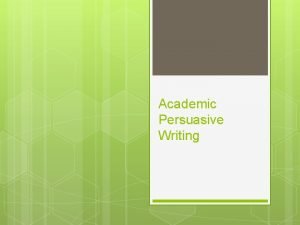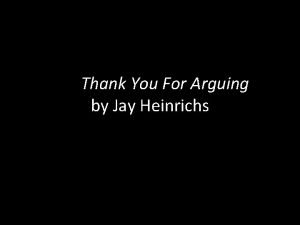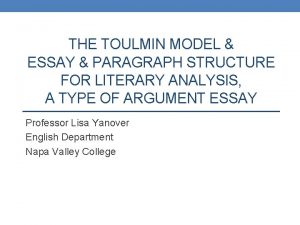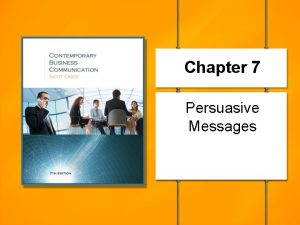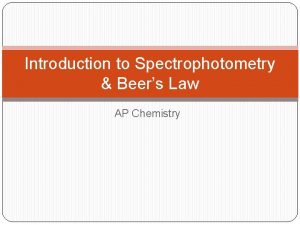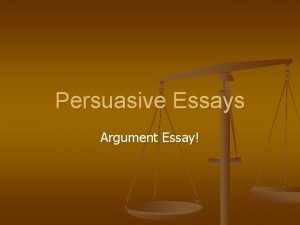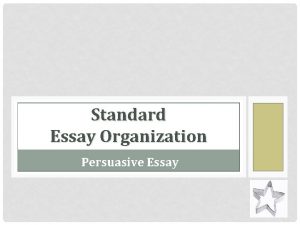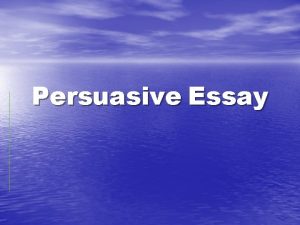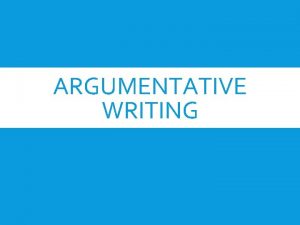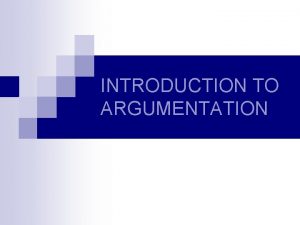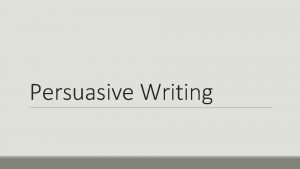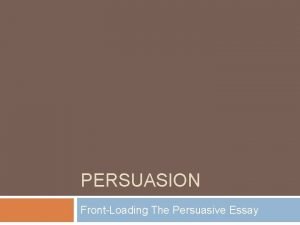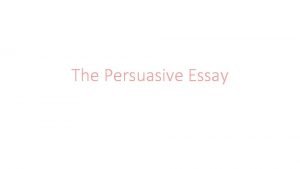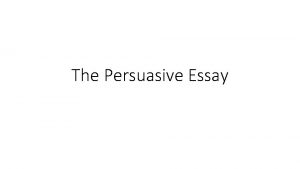Free Response Open Argument Persuasive Essay 3 Persuasion













- Slides: 13

Free Response, Open Argument, Persuasive Essay 3. Persuasion and the AP Exam: The final essay is a position argument like the first one (Synthesis), but without any sources provided. It will present a debatable statement, and then ask you to take one side of the argument, and support your argument with appropriate evidence from your reading, observation, or experience.

The Prompt Defend, Challenge, or Qualify prompts usually take three forms: � Respond to a relatively brief quotation � Thomas Jefferson wrote, “Determine never to be idle. . . It is wonderful how much may be done if we are always doing. ” Do we accomplish more if we are always doing something, or does inactivity also serve a purpose? Take a position on this question. Support your response with reasons and specific examples.

The Prompt � Respond � to a passage of some length The following passage is from Rights of Man, a book written by the pamphleteer Thomas Paine in 1791. Born in England, Paine was an intellectual, a revolutionary, and a supporter of American independence from England. Read the passage carefully. Then write an essay that examines the extent to which Paine’s characterization of America holds true today. Use appropriate evidence to support your argument. If there is a country in the world, where concord, according to common calculation, would be least expected, it is America. Made up, as it is, of people from different nations, accustomed to different forms and habits of government, speaking different languages, and more different in their modes of worship, it would appear that the union of such a people was impracticable; but by the simple operation of constructing government on the principles of society and the rights of man, every difficulty retires, and all the parts are brought into cordial unison. There, the poor are not oppressed, the rich are not privileged. . Their taxes are few, because their government is just; and as there is nothing to render them wretched, there is nothing to engender riots and tumults.

The Prompt � Open-ended � It has been said that first impressions are almost impossible to change. Based on your experiences, do you agree or disagree with this statement? Take a position on this issue. Support your response with reasons and specific examples. � Authors Po Bronson and Ashley Merryman published “The Creativity Crisis” in Newsweek. com in July 2010. They reported that the Torrance Test, a test of creativity that has been administered to millions of people worldwide in 50 languages, indicates that the public’s “creativity quotient” has steadily crept downward since 1990. In their article, Bronson and Merryman cite the claim of Professor Kyung Hee Kim at the College of William and Mary: “It’s very clear, and the decrease is very significant. ” Kim reports that it is the scores of younger children in America—from kindergarten through sixth grade—for whom the decline is “most serious. ” Bronson and Merryman state that “[t]he potential consequences are sweeping. The necessity of human ingenuity is undisputed. A recent IBM poll of 1, 500 CEOs identified creativity as the No. 1 ‘leadership competency’ of the future. Yet it’s not just about sustaining our nation’s economic growth. All around us are matters of national and international importance that are crying out for creative solutions, from saving the Gulf of Mexico to bringing peace to Afghanistan to delivering health care. Such solutions emerge from a healthy marketplace of ideas, sustained by a populace constantly contributing original ideas and receptive to the ideas of others. ” One possible approach to this reputed decline in creativity is to explicitly teach creative thinking in school. Write to your school board explaining what you mean by creativity and arguing for or against the creation of a class in creativity. � �

The Wording The prompts may be worded in a number of ways: • Write an essay that defends, challenges, or qualifies… • Write a carefully argued essay that agrees or disagrees with… • Write an essay in which you develop a position on the issue of. . . • Write an essay in which you consider the extent to which an author’s observation holds true. . . • Write an essay that explores the validity of. . . • Write an essay in which you evaluate the pros and cons of the author’s argument. Use appropriate evidence as you examine each side, and indicate which position you find more persuasive. . .

Terminology � Defend = support � Challenge = oppose or refute � Qualify = To what extent is the assertion true or untrue? To what extent do you agree or disagree?

Your Argument � First, COME UP WITH AN ARGUMENT! Do NOT be hesitant. There is no right or wrong. � Consider your options in terms of responding. You may fully agree with one “side” or the other. � Or, you may qualify. Be sure, however, that you have a clear claim supported by appropriate evidence. ***Do not provide evidence for both sides without clearly taking a position of your own. ***

Support for your Argument � With evidence that is specific. � With evidence derived from your observation, experience, or reading. � By drawing on your own knowledge. � By using your own critical understanding of… � By using appropriate evidence or support.

Evidence Types of Evidence Examples � Reasons � Causes � Effects � Details � Facts � Figures � Expert Opinion � Quotations � Precedents � Parallels � Where you can derive your evidence � History � Current Event � Pop Culture � Business and Industry � Environment � Literature � Technology � Experience � YOUR BRAIN!

How to use the Evidence � Make sure your evidence is SPECIFIC! � Avoid generalizations and absolutes like: always, never, all, none. Use “qualifiers” such as: often, in many cases, frequently, sometimes.

How to use the Evidence � Evidence from literature should “zoom in” on one moment with 1 -2 character(s) as the focus. The evidence should be specific! � Evidence from current events or history should be focused on a particular moment or narrowed event (rather than, for example, World War II in general). � Evidence from personal experience should be focused on a particular moment that will be taken seriously by your audience (Anecdotes). � Consider CONGRUITY of examples – Going from world war to personal heartache requires a meaningful transition (sometimes several sentences of “buffer”/transition); otherwise, one of your examples may come across as trivial.

How to use the Evidence � Evidence from social observation requires specific details in some form to get beyond broad generalizations. � Evidence from pop culture must be thoughtful. Movie and book examples should be “weighty” enough that they will be taken seriously by your reader. � Hypothetical evidence is often ineffective. Readers are generally not persuaded by something that has not actually happened.

THE COUNTER CLAIM � This is an appeal to logos in your writing where you address the other side of your argument, acknowledge it, refute it, and get right back to your claim. � Do not have a counter claim in your introduction. � Do not start a body paragraph with a counter claim. � Do not devote an entire body paragraph to a counter claim. � Do not concede your point. � Address the counter claim, and then refute it. � Take a side, have an opinion, and let your voice come through!
 Argument vs persuasion
Argument vs persuasion Open innovation open science open to the world
Open innovation open science open to the world Teleological argument vs ontological argument
Teleological argument vs ontological argument Gaunilo's response to anselm's ontological argument
Gaunilo's response to anselm's ontological argument Natural response and forced response
Natural response and forced response Natural response circuit
Natural response circuit Primary immune response and secondary immune response
Primary immune response and secondary immune response Open your eyes the invisible argument
Open your eyes the invisible argument Toulmin model of argument essay outline
Toulmin model of argument essay outline Ap gov argument essay example
Ap gov argument essay example Rogerian format
Rogerian format Example of open letter format
Example of open letter format Unlike routine claims, persuasive claims:
Unlike routine claims, persuasive claims: Absorbance chemistry
Absorbance chemistry
